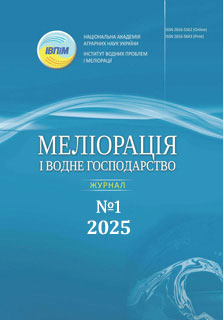ESTIMATION OF THE ACCURACY OF THE CALCULATION OF REFERENCE AND ACTUAL EVAPOTRANSPIRATION BASED ON VIRTUAL WEATHER STATION DATA FOR POLISSYA REGION OF UKRAINE
Abstract
This article evaluates the accuracy of calculating reference and actual evapotranspiration using Virtual Visual Crossing Weather Data (VCWD) and automatic iMetos Base meteorological station data in Polissya, Ukraine. The study confirmed the feasibility of calculating ETo and ETc using VCWD meteorological data. The ETo calculation is 86,1% accurate, with an RMSE and SEE error of 0,76 and 0,49 mm, respectively. The ETo calculation with correction factors for meteorological data increases its accuracy by 1,4%, and the RMSE error decreases by 0,08 mm. The most accurate calculations were obtained using a correction factor of 1,1 to the calculated ETo. With the correction factor applied, the ETo determination accuracy is 88,9%, with RMSE and SEE errors of 0,58 and 0,54 mm, respectively. The ETo data from VCWD were obtained with satisfactory accuracy; the largest errors in the MAPE, RMSE, and SEE were 20,4%, 1.09 mm, and 1,02 mm, respectively. For 2023–2024, the FEA, RMSE, and SEE errors for ETo calculated from VCWD meteorological data, accounting for the 1,1 correction factor, were 10,0–12,2%, 0,55–0,60, and 0,51–0,55 mm, respectively. During the research period, the MAPE, RMSE, and SEE errors for this variant were 9,0%-14,0%, 0,52-0,63 mm, and 0,34-0,56 mm, respectively. The calculation of absolute errors in determining ETo confirms that the most reliable data of reference evapotranspiration are obtained using the correction factor. This option resulted in the smallest average absolute error by years of research, which is 5 mm, and in 2024 this error was 0. In terms of months, the smallest absolute error of 2 mm was observed in May and August, and the largest -13 mm in September.
The results of the calculations of actual evapotranspiration (ETc) of crops showed that using a correction factor of 1,1 to ETo increases the accuracy of ETc calculations. The mean absolute relative error (MAPE) decreased by 2,1% for all crops, and the root mean square error (RMSE) decreased by 0,16, 0,15, and 0,09 mm for corn, potatoes, and blueberries, respectively. The average absolute ETc errors by year of research using a correction factor of 1,1 for ETo were 15,7, and 11 mm for corn, potatoes, and blueberries, respectively. In May, June, and July, the calculated ETc for corn seed was 11,6, and 8 mm lower than the actual values. In August and September, it was 1 and 9 mm higher, respectively. This trend in the errors distribution is also observed for potatoes and blueberries.
References
2. Allen, R.G., Dhungel, R., Dhungana, B., Huntington, Ju., Kilic A., & Morton, Ch. (2021). Conditioning point and gridded weather data under aridity conditions for calculation of reference evapotranspiration. Agricultural Water Management, 245, 106531. DOI: https://doi.org/10.1016/j.agwat.2020.106531
3. Veysi, Sh., Nouri, M., & Jabbari, A. (2024). Reference evapotranspiration estimation using reanalysis and WaPOR products in dryland croplands. Heliyon, 10, e26531. DOI: https://doi.org/10.1016/j.heliyon.2024.e26531
4. Rodrigues, G.C., & Braga, R.P. (2021). Estimation of Daily Reference Evapotranspiration from NASA POWER Reanalysis Products in a Hot Summer Mediterranean Climate. Agronomy, 11, 2077. DOI: https://doi.org/10.3390/agronomy11102077
5. Paredes, P., Trigo, I., de Bruin, H., Simões, N., & Pereira, L.S. (2021). Daily grass reference evapotranspiration with Meteosat Second Generation shortwave radiation and reference ET products. Agricultural Water Management, 248, 106543. DOI: https://doi.org/10.1016/j.agwat.2020.106543
6. Blankenau, P.A., Kilic, A., & Allen, R. (2020). An evaluation of gridded weather data sets for the purpose of estimating reference evapotranspiration in the United States. Agricultural Water Management, 242, 106376. DOI: https://doi.org/10.1016/j.agwat.2020.106376
7. Paredes, P., Pereira, L.S., Almorox, J., & Darouich, H. (2020). Reference grass evapotranspiration with reduced data sets: Parameterization of the FAO Penman-Monteith temperature approach and the Hargeaves-Samani equation using local climatic variables. Agricultural Water Management, 240, 106210. DOI: https://doi.org/10.1016/j.agwat.2020.106210
8. Faramiñan, A., Rodriguez, P.R., Carmona, F., Holzman, M., Rivas, R., & Mancino, Ch. (2022). Estimation of actual evapotranspiration in barley crop through a generalized linear model. MethodsX, 9, 101665. DOI: https://doi.org/10.1016/j.mex.2022.101665
9. Pareeth, S.. & Karimi, P. (2023). Evapotranspiration estimation using Surface Energy Balance Model and medium resolution satellite data: An operational approach for continuous monitoring. Scientific Reports, 13, 12026. DOI: https://doi.org/10.1038/s41598-023-38563-2
10. Vázquez-Rodríguez, B.A., Ontiveros-Capurata, R.E., González-Sánchez, A., & Ruíz-Álvarez, O. (2024). Comparative analysis of actual evapotranspiration values estimated by METRIC model using LOCAL data and EEFlux for an irrigated area in Northern Sinaloa, Mexico. Heliyon, 10, e34767. DOI: https://doi.org/10.1016/j.heliyon.2024.e34767
11. Visual Crossing Weather Data. Historical Weather Data & Weather Forecast Data. (2025). Retrieved from: https://www.visualcrossing.com
12. FieldClimate - Metos® by Pessl instrument. (2025). Retrieved from: https://ng.fieldclimate.com
13. Allen, R.G., Pereira, L.S., Raes, D., & Smith, M. (1998). Crop evapotranspiration. Guidelines for computing crop water requirements. FAO Irrig. Drain. Paper No. 56, Rome: FAO. Retrieved from: http://www.fao.org/3/x0490e/x0490e00.htm
14. Roberts, A. (2023). Mean Absolute Percentage Error (MAPE): What You Need To Know. Retrieved from: https://arize.com/blog-course/mean-absolute-percentage-error-mape-what-you-need-to-know/.
15. Lewis, C.D. (1982). Industrial and business forecasting methods. London: Butterworths. P.144.
16. Olumide, S. (2023). Root Mean Square Error (RMSE) In AI: What You Need To Know. Retrieved from: https://arize.com/blog-course/root-mean-square-error-rmse-what-you-need-to-know/.
17. Watts, V. (2022). Introduction to Statistics. An Excel-Based Approach. London, Ontario: Fanshawe College Pressbooks. P. 916. Retrieved from: https://ecampusontario.pressbooks.pub/introstats/
18. Zhuravlov, O.V., Shatkovskyi, A.P., Cherevychnyi, Y.O., Shcherbatiuk M.V., & Liubitskyi, V.V. (2024). Assessment of the accuracy of meteorological data obtained from virtual and automatic weather stations for the conditions of Ukrainian Polissya. Land reclamation and water management, 2(120), 87-98. DOI: https://doi.org/10.31073/mivg202402-396


